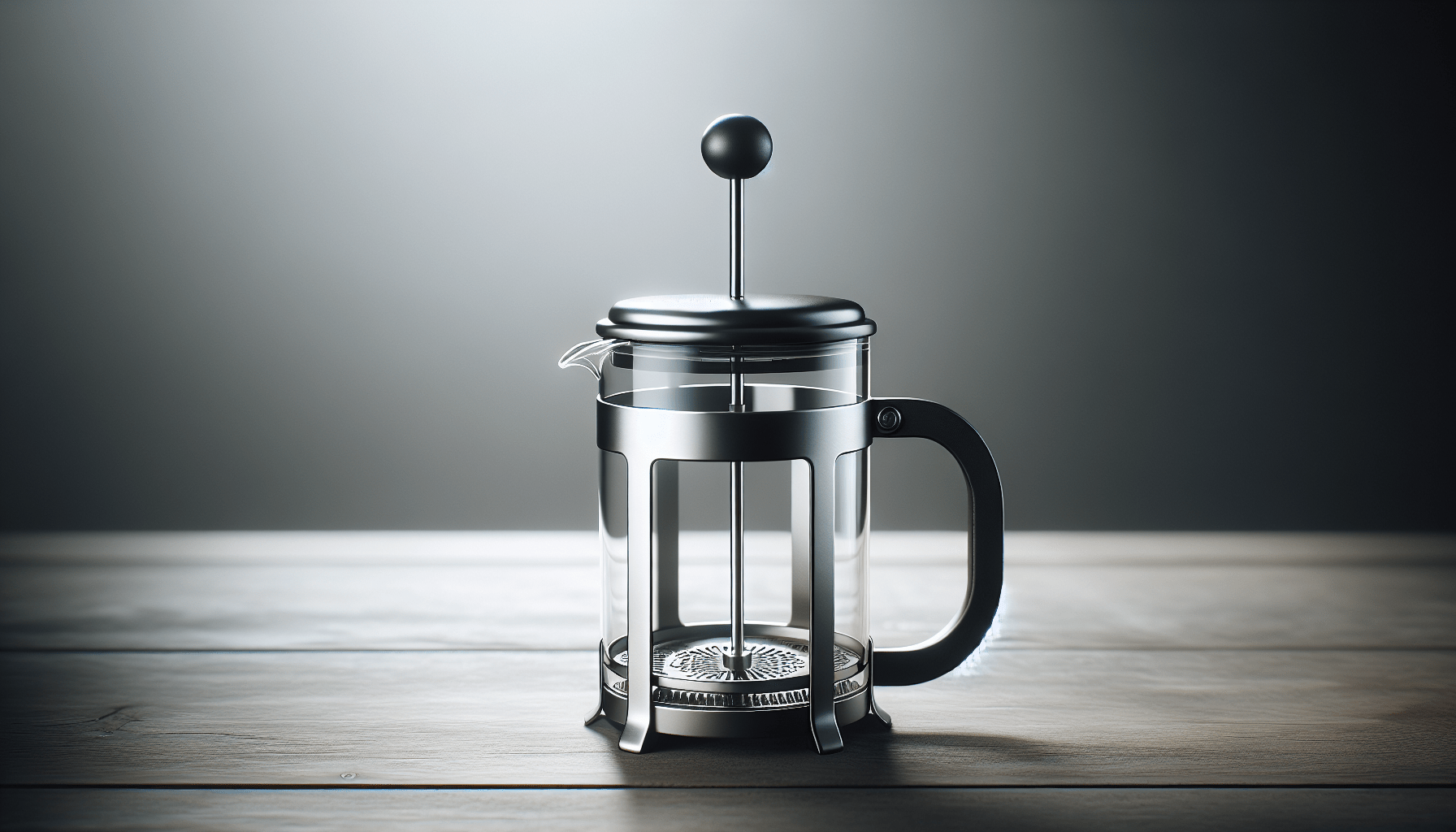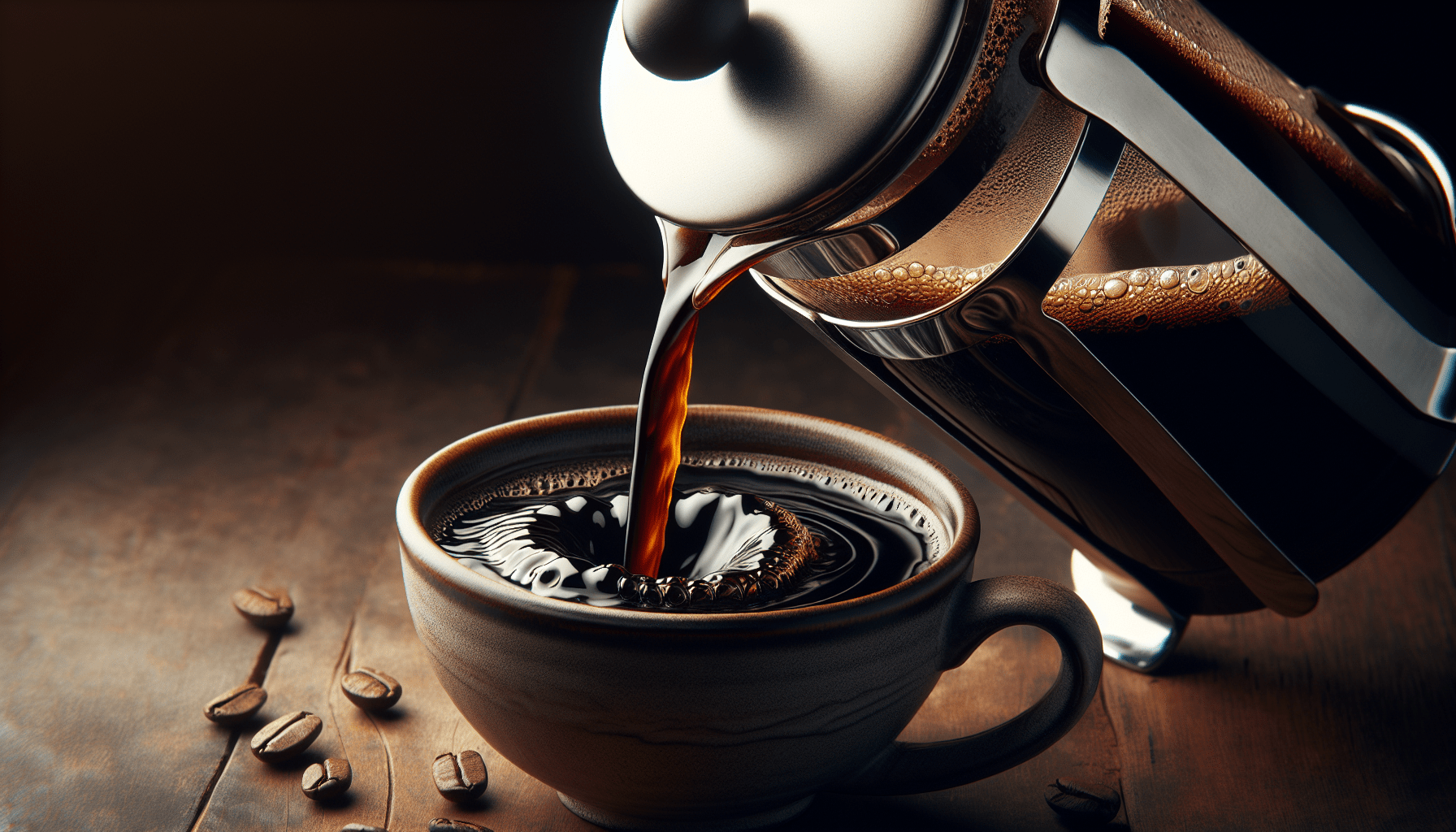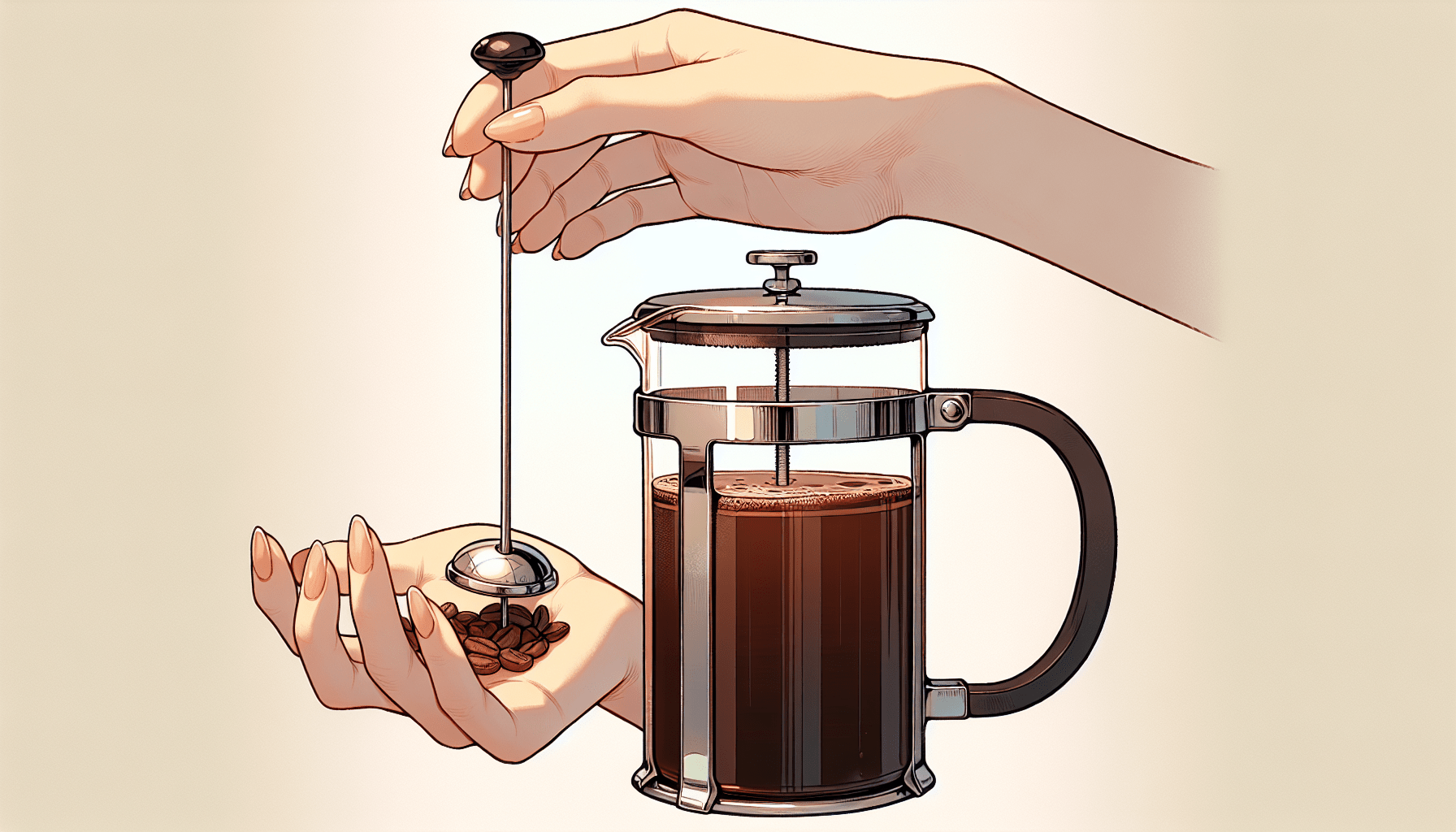If you’ve ever made coffee with a French press, you’ll understand the frustration that comes with finding coffee grounds floating at the bottom of your cup. It’s a common issue that can leave you feeling disappointed and in need of a solution. But fear not, because in this article, we’ll explore some simple yet effective techniques to prevent those pesky grounds from ruining your morning brew. From choosing the right grind size to mastering the art of the pour, we’ve got you covered. So grab your French press and get ready to enjoy a smooth, grit-free cup of coffee every time.
Choosing the Right Grind Size
Understanding the Importance of Grind Size
Choosing the right grind size for your French press coffee is crucial in achieving the perfect cup of joe. The grind size refers to the coarseness or fineness of the coffee grounds. The size of the grind affects the extraction process, impacting the flavor and strength of your brew.
Optimal Grind Size for French Press
For French press coffee, a coarse grind size is recommended. This means that the coffee grounds should be larger and have a rougher texture compared to finer grinds used in other brewing methods. A coarse grind allows for a slower extraction process, resulting in a fuller-bodied and well-balanced cup of coffee.
Using a Burr Grinder for Consistency
To achieve the optimal grind size for your French press, it is highly recommended to use a burr grinder. Unlike blade grinders, which chop the coffee beans unevenly, burr grinders crush the beans between two abrasive surfaces, resulting in a more consistent grind size. Consistency is key in French press brewing to ensure even extraction and avoid over or under-extraction.
Proper Coffee-to-Water Ratio
Determining the Ideal Ratio
Getting the coffee-to-water ratio right is essential in achieving a well-balanced and flavorful French press brew. The ideal ratio is often considered to be 1:15, which means one part coffee to 15 parts water. However, this can be adjusted based on personal preference. If you prefer a stronger cup, you can increase the coffee-to-water ratio slightly.
Using a Kitchen Scale for Precision
To ensure accuracy and precision in your coffee-to-water ratio, it is recommended to use a kitchen scale. Measuring by weight rather than volume allows for consistent results. Simply weigh your desired amount of coffee and water using grams or ounces and adjust the ratio accordingly.
Measuring Tools for Reference
If you don’t have access to a kitchen scale, you can use measuring spoons as a reference. The general guideline is to use one tablespoon of coffee for every 4 ounces of water. However, keep in mind that this is only an approximation, and using a scale will yield more consistent results.
Blooming the Coffee
What is Coffee Blooming?
Coffee blooming is the process of saturating the freshly ground coffee with a small amount of hot water before the full brewing begins. This step allows the coffee grounds to release trapped gases, such as carbon dioxide, resulting in a more even extraction and a better-tasting cup of coffee.
Benefits of Blooming in French Press
Blooming is particularly important in French press brewing because it helps degas the coffee grounds, which can cause the coffee to become bitter and unevenly extracted. By blooming the coffee, you ensure that the extraction process starts on an even playing field, leading to a more balanced and flavorful brew.
Step-by-Step Guide to Blooming
- Start by preheating your French press and pouring hot water into it to warm up the vessel.
- Add the desired amount of freshly ground coffee to the French press.
- Slowly pour a small amount of hot water over the coffee grounds, just enough to saturate them. The water should be heated to around 200°F (93°C).
- Let the coffee bloom for about 30 seconds to a minute.
- After the blooming period, gently pour the rest of the hot water over the coffee grounds to complete the brewing process.
Temperature and Brew Time
Optimal Water Temperature
The water temperature plays a significant role in the extraction process and ultimately affects the taste of your French press coffee. It is recommended to use water that is heated to around 200°F (93°C). This temperature allows for optimal extraction without scalding the coffee grounds or extracting undesirable flavors.
Importance of Brew Time
The brew time for French press coffee typically ranges between 4 to 6 minutes. The brew time affects the strength and flavor profile of the coffee, with longer brew times resulting in stronger and more robust flavors. However, it’s important to note that brew times can vary based on personal preference and the desired strength of the coffee.
Controlling Variables for Desired Results
To achieve consistent and desired results when it comes to temperature and brew time, it is crucial to control the variables. Preheating your French press, using a reliable thermometer to measure the water temperature, and monitoring the brew time with a timer can help maintain consistency and ensure a delicious cup of coffee every time.
Stirring and Breaking the Crust
Purpose of Stirring
Stirring the coffee grounds during the brewing process is an essential step in French press brewing. It helps promote an even extraction by ensuring that all the coffee grounds are fully saturated and in contact with the water. Stirring also helps break up any clumps or denser areas of coffee grounds, preventing under-extraction.
Techniques for Breaking the Crust
To break the crust formed by the coffee grounds during brewing, there are a few techniques you can employ. One common method is gently agitating the surface with a spoon, ensuring that all the coffee grounds are evenly distributed. Another technique is to gently push down on the bloomed coffee grounds with the back of a spoon to break the crust.
Timing and Process
Stirring and breaking the crust should be done towards the end of the brewing process, just before plunging the French press. It is recommended to stir and break the crust for about 10 to 15 seconds to ensure that all the coffee grounds are thoroughly mixed and ready for the final step of the brewing process.
Gentle Plunge Technique
Benefits of Gentle Plunging
Employing a gentle plunge technique when using a French press offers several benefits. Firstly, it minimizes the risk of grounds escaping into your coffee, resulting in a cleaner cup. Secondly, it helps reduce the potential for over-extraction, which can lead to a bitter taste. Lastly, a gentle plunge helps preserve the flavors and aromas locked within the coffee grounds.
Avoiding Forceful Pressure
When plunging the French press, it is important to avoid applying excessive force or pressure. Forcing the plunger down forcefully can lead to uneven extraction and the presence of coffee grounds in your cup. Instead, use a slow and steady motion to push the plunger down, maintaining control and ensuring a clean and delicious brew.
Proper Plunge Speed
The speed at which you plunge the French press can also impact the final results. Plunging too quickly can agitate the coffee grounds and result in a less desirable brew. Aim for a consistent and controlled plunge speed, taking around 20 to 30 seconds to complete the process. This allows for optimal extraction and a smoother cup of coffee.
Pouring and Serving
Avoiding Agitation and Swirling
When it comes to pouring and serving your French press coffee, it is essential to avoid agitating or swirling the coffee too vigorously. Agitation can disturb the settled grounds and lead to unwanted sediment in your cup. Instead, opt for a gentle and controlled pour, ensuring that you leave any sediment behind in the French press.
Utilizing a Slow and Controlled Pour
To achieve a smooth and well-balanced cup of French press coffee, utilize a slow and controlled pour. Pouring too quickly can result in a turbulent flow, potentially causing grounds to make their way into the cup. By pouring slowly and steadily, you allow the coffee to cascade smoothly, minimizing the likelihood of any unwanted residue.
Serving Techniques
To ensure that each cup of French press coffee is served at its best, there are a few techniques to consider. Firstly, pour the brewed coffee into preheated cups or mugs to help retain the heat. Secondly, serve the coffee immediately after brewing to enjoy it at its freshest. Lastly, avoid leaving any residual coffee in the French press for extended periods, as it can lead to over-extraction and a less enjoyable flavor.
Using a Secondary Filter
Types of Secondary Filters
While the French press already has a built-in metal mesh filter, using a secondary filter can further enhance the clarity of your coffee. There are various types of secondary filters available, such as reusable stainless steel filters, paper filters, or fine mesh filters. Each type has its benefits and can help reduce sediment and grounds in your cup.
Advantages of Using One
Using a secondary filter alongside the French press offers several advantages. It helps create a cleaner cup of coffee by trapping smaller coffee particles and residue that may pass through the metal mesh of the French press filter. Additionally, it can improve the mouthfeel of the coffee, resulting in a smoother and more refined drinking experience.
Positioning and Handling
When using a secondary filter, it is important to position it correctly in the French press. Depending on the type of filter, it may need to be placed either underneath or on top of the metal mesh filter. Follow the manufacturer’s instructions for proper positioning. Additionally, handle the filter with care to avoid tearing or damaging it during use.
Cleaning and Maintenance
Regular Cleaning to Prevent Residue
To ensure the longevity of your French press and maintain the quality of your coffee, regular cleaning is essential. After each use, rinse the French press thoroughly to remove any residual coffee grounds. Once a week, give it a deeper clean by disassembling the parts and washing them with warm, soapy water. This helps prevent residue buildup and ensures a fresh taste with every brew.
Removing Any Remaining Grounds
Despite your best efforts, there may be times when some coffee grounds remain stuck in the French press. To remove them, gently scrub the interior walls of the container with a soft brush or sponge. Be thorough in your cleaning to ensure that no residue is left behind, as this can affect the taste of future brews.
Maintenance Tips for Longevity
To prolong the life of your French press and ensure consistent performance, there are a few maintenance tips to keep in mind. Firstly, avoid using abrasive sponges or cleaners that can scratch the glass or metal surfaces. Secondly, handle the French press with care to prevent accidental drops or damage. Lastly, store the French press in a dry place to prevent any lingering moisture that could lead to mold or rust.
Troubleshooting Tips
Common Issues and Solutions
Like any brewing method, French press coffee brewing can occasionally encounter some issues. Some common problems include a muddy or overly thick brew, excessive sediment, or a bitter taste. To address these issues, try adjusting the grind size, coffee-to-water ratio, and brew time. Experiment with different variables until you find the perfect combination that suits your taste preferences.
Adjusting Variables for Desired Taste
French press brewing allows for a certain level of control over the variables, making it easy to adjust the taste. If you prefer a stronger brew, increase the coffee-to-water ratio or extend the brew time slightly. For a milder cup, decrease the amount of coffee or reduce the brew time. Experimentation is key in finding the perfect taste profile that satisfies your preferences.
Experimenting to Find the Perfect Brew
French press brewing is a versatile and customizable method, making it a perfect opportunity for experimentation. Feel free to try different coffee beans, grind sizes, brew times, and ratios until you achieve your ideal cup of coffee. Whether you prefer bold and robust flavors or a milder brew with delicate notes, the French press offers endless possibilities to explore and enjoy.




